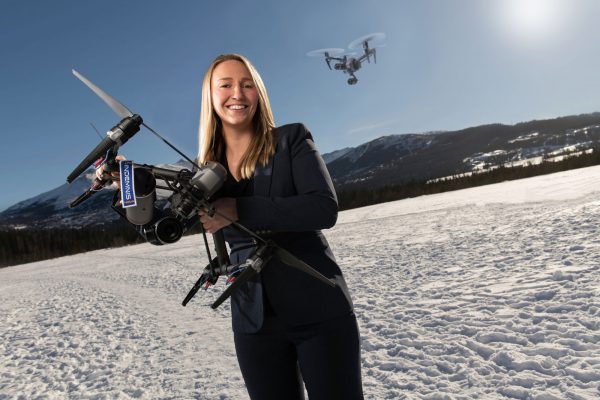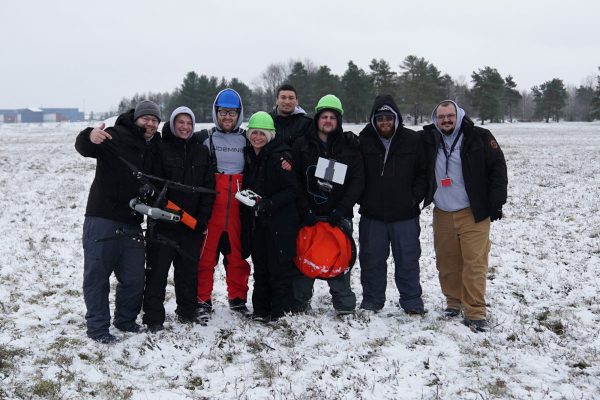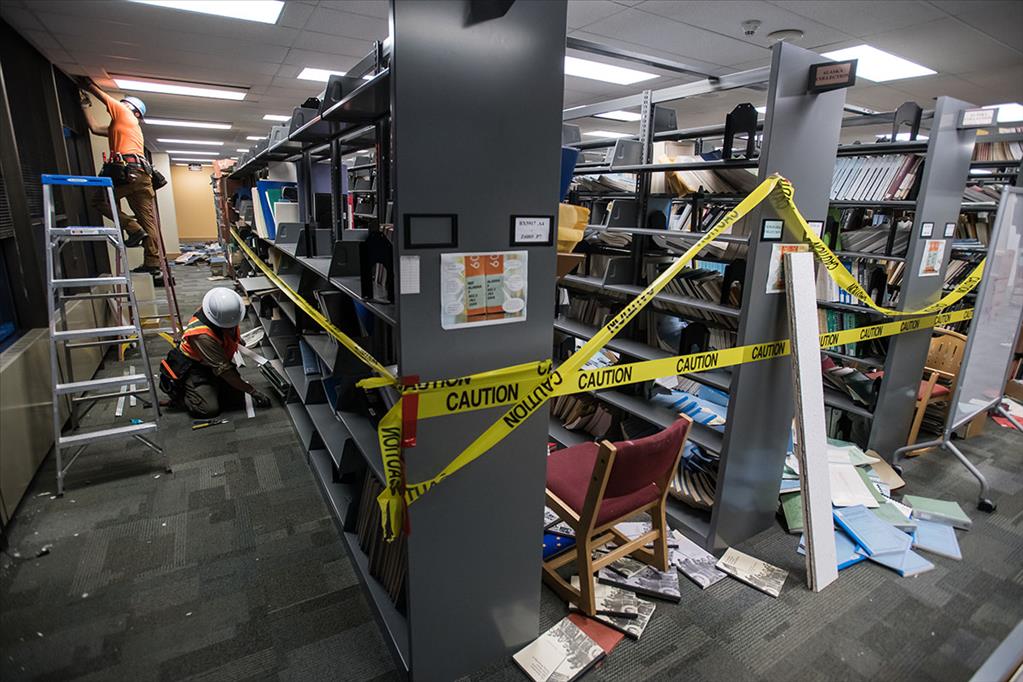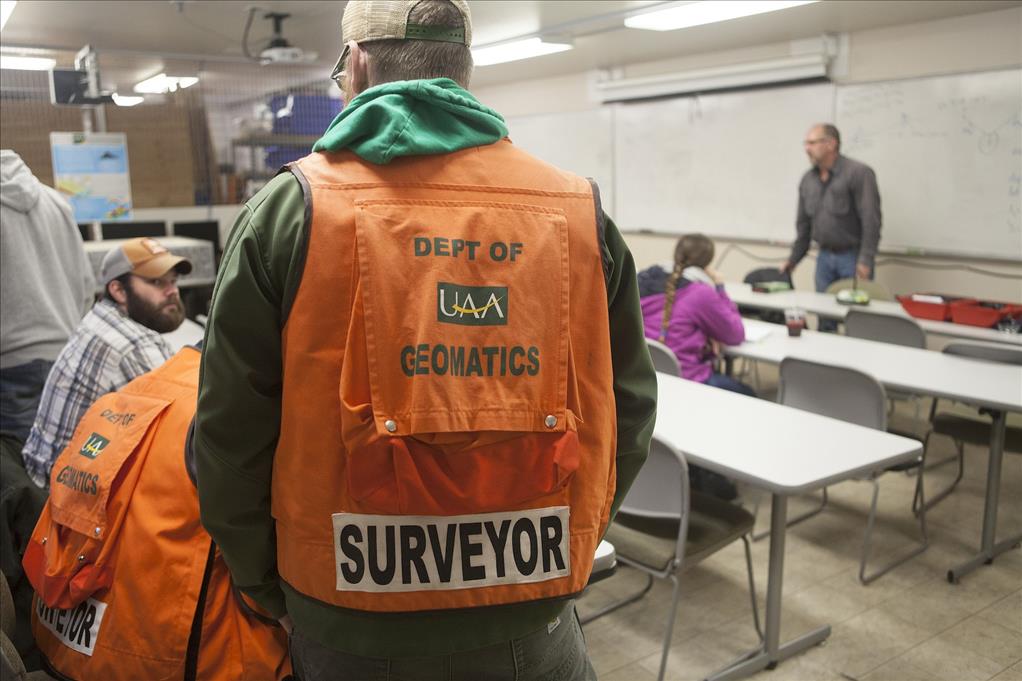Drone safety from the ground up
by Matt Jardin |

Amber McDonald, B.A. '10, is president, CEO and co-founder of Indemnis, Inc., an Anchorage startup on a mission to minimize damage from falling drones. Since establishing the company in 2016, they've been able to raise $4.2 million from private investors, secure a partnership with the world's leading drone manufacturer, and become the only drone safety technology to receive certification from the American Society for Testing and Materials. (Photo by James Evans / University of Alaska Anchorage)
If a penny is dropped from a skyscraper and hits a person on the ground, how much harm would it cause? While the urban legend is seemingly brought up time and time again, what isn't up in the air is how much damage a crashing drone could do to the buildings and people below.
"The reality is that if 20 pounds falls out of the sky and hits you, that's not just hurting you, it's killing you," stresses journalism and public communications alumna Amber McDonald.
McDonald is the president, CEO and co-founder of Indemnis, Inc., an Anchorage startup on a mission to minimize damage from falling drones. It's a scenario McDonald and the rest of the company is familiar with. Before launching Indemnis, most of the founders worked together in film production and witnessed how often drones can fail. The company's commitment to safety is even evident in its name, as indemnis is Latin for "without injury or damage."
Safety remains the biggest obstacle facing the burgeoning drone industry. PricewaterhouseCoopers estimates the global market for the commercial application of drones will reach a value of $127 billion by 2020. Adopting this new technology also has the potential to revolutionize a host of industries - farmers would be able to spray crops in a fraction of the time, land surveyors could observe dangerous sites without risk, and search and rescue teams could cover more ground when every second counts.
Despite being ready for takeoff, the Federal Aviation Administration and other regulatory bodies have placed strict controls on drone use, limiting how big they can be, how much they can weigh, what time of day they can fly and how fast they can travel. Perhaps most restricting is the ruling that drones aren't permitted to fly over large crowds of people, effectively grounding the widespread use of drones to make deliveries.
"That's the Holy Grail for us right now," shares McDonald. "You have everyone from Amazon, UPS, Domino's Pizza, Walmart, Home Depot - if you could pull out your phone in any major urban area and have your package in 30 minutes, you'd pay an extra $2 for that."
Similar to how their background as filmmakers gave McDonald and company unique insight into drone failure, their background as filmgoers proved to be the inspiration for their first safety solution.
According to McDonald, the company's first product - dubbed the SLS - was born after Indemnis' CTO and co-founder Alan Erickson got the idea while watching a James Bond movie, where the titular spy survives an avalanche by encasing himself in a protective, inflatable bubble housed in his jacket.
"If you could do that concept on a drone, it would essentially protect anything it ran into - life, property, any of the above," McDonald explains.
[embed]https://www.youtube.com/watch?v=qgXKDMLWNGk[/embed]
The SLS was a strong first step toward a drone safety solution, but it was Indemnis' second product that really propelled the company forward. At that point, the protective bubble was considered more of a workaround for an idea other companies have struggled to make work for years: parachutes. When a drone begins to fall, any parachute deployed from the drone just ends up getting entangled with the propellers.
While workshopping improvements to the SLS, McDonald and Erickson revisited the use of parachutes and developed a fix to the problem that plagued the drone industry. By moving the parachute's launch point away from the drone's body, it can successfully deploy without getting caught in the propellers. And so, the Nexus was born, proving the second time's the charm for Indemnis.
The Nexus itself is a welded tube that sits on the drone's frame. When the sensors indicate the drone is entering a failure scenario, or when activated manually via remote control, the Nexus inflates a tube in 30 milliseconds. From that tube, a parachute is deployed at 90 mph, safely avoiding the drone's body and propellers, and quickly decreasing the drone's fall speed.
Key to the Nexus is the use of Dyneema material for the construction of the tube, for which Indemnis developed and patented the bonding technique. According to the manufacturer's website, Dyneema is 15 times stronger than steel and light enough to float on water, making it the only material strong enough to withstand the ballistic launch of the parachute.

The Nexus is a welded tube that sits on the drone's frame. When sensors indicate a failure scenario, or when activated via remote control, the Nexus inflates a tube in 30 milliseconds. From that tube, a parachute is deployed at 90 mph, safely avoiding the propellers and quickly decreasing fall speed. (Photo courtesy of Amber McDonald / Indemnis, Inc.)
"That's our No. 1 milestone, the ability to weld Dyneema. It's what makes our product possible," says McDonald. "There's not another material on the planet that would be able to handle that level of energy and not blow to shreds. We developed the bonding technology to be able to fuse it to create a seam that is stronger than the base material itself. No one's ever been able to do that, and we actually just received a patent on that."
After that first milestone, more have quickly been added to the list. By demonstrating a working concept of the Nexus, Indemnis has been able to cut their own piece of the multibillion-dollar pie. So far, the startup has raised $4.2 million from private investors and secured a partnership with DJI, the world's leading drone manufacturer, accounting for 70 percent of the global market.
Most recently in December 2018, the Nexus became the only drone safety technology to pass compliance standards set by the American Society for Testing and Materials. The certification is a crucial demonstration to the FAA as it slowly but surely works to find a way to guarantee the safe widespread application of drones.
While Indemnis continues to work toward FAA approval, McDonald is making sure her team is ready when it arrives by preparing the company for their next milestone: officially launching the Nexus in summer 2019. And after that, the sky's the limit.
"We definitely want to adapt for other platforms. Our technology is completely scalable," describes McDonald. "Eventually, we're going to be like the Jetsons. Flying around in cars is a hard concept for people to wrap their head around, but so were airplanes. The funny thing is if somebody told you 10 years ago that you're going to be walking around with a computer attached to you, you would've laughed at them. But now your phone can track everything from your fingerprint to your location. I've just surrendered my life to technology and decided that it's going to go where it's going to go."
Written by Matt Jardin, UAA Office of University Advancement
 "Drone safety from the ground up" is licensed under a Creative Commons Attribution-NonCommercial 4.0 International License.
"Drone safety from the ground up" is licensed under a Creative Commons Attribution-NonCommercial 4.0 International License.















